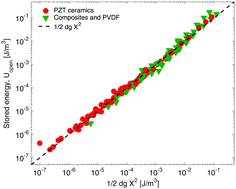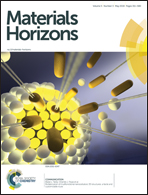Analysis and experimental validation of the figure of merit for piezoelectric energy harvesters†
Abstract
Piezoelectric energy harvesters are at the front of scientific research as enablers of renewable, sustainable energy for autonomous wireless sensor networks. Crucial for this disruptive technology is the achievable output power. Here we show, analytically, that the maximum output energy per unit volume, under a single sinusoidal excitation, is equal to 1/(4 − 2k2) × 1/2dgX2, where k2 is the electromechanical coupling coefficient, d and g are the piezoelectric charge and voltage coefficient, respectively, and X is the applied stress. The expression derived is validated by the experimentally measured output energy for a variety of piezoelectric materials over an unprecedented range of more than five orders of magnitude. As the prefactor 1/(4 − 2k2) varies only between 1/2 and 1/4 the figure of merit for piezoelectric materials for energy harvesters is not k2, as commonly accepted for vibrational harvesters, but dg. The figure of merit does not depend on the compliance, or Young's modulus. Hence we argue that commonly used brittle inorganic piezoelectric ceramics can be replaced by soft, mechanically flexible polymers and composite films, comprising inorganic piezoelectric materials embedded in a polymer matrix.



 Please wait while we load your content...
Please wait while we load your content...